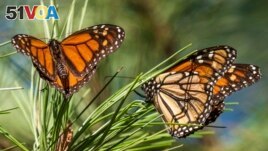24 July 2022
Scientists now consider the migrating monarch butterfly to be endangered. The population of the beloved orange-and-black insect has dropped quickly in recent years.
The International Union for the Conservation of Nature (IUCN) added the migrating monarch to its "red list" of threatened organisms. They said it is "endangered." That means it is two steps from being extinct. When a species is extinct, there are no more living members.
Stuart Pimm is an ecologist at Duke University in North Carolina. He was not involved in the new listing. He said, "It's just a devastating decline. This is one of the most recognizable butterflies in the world."

FILE - Monarch butterflies land on branches at Monarch Grove Sanctuary in Pacific Grove, Calif., Wednesday, Nov. 10, 2021.
IUCN estimates that the population of monarch butterflies in North America has fallen between 22 percent and 72 percent over 10 years, depending on the measurement method.
Nick Haddad is a conservation biologist at Michigan State University. He said, "What we're worried about is the rate of decline. It's very easy to imagine how very quickly this butterfly could become even more imperiled." Imperiled means to be in a dangerous situation.
Haddad estimates that the population of monarch butterflies he studies in the eastern United States has declined between 85 percent and 95 percent since the 1990s.
In North America, millions of monarch butterflies carry out the longest migration of any insect species known to scientists. Animals migrate when they move from one location to another depending on the season.
Monarch butterflies spend the winter in the mountains of central Mexico. Then they start their journey to the north. They reproduce many times along the way, for thousands of kilometers. The young butterflies that reach southern Canada then begin the trip back to Mexico at the end of summer.
A smaller group of butterflies spends winters in coastal California, then flies away in spring and summer across several states west of the Rocky Mountains. This population has seen an even sharper drop than the eastern monarchs, although there was a small increase last winter.
Emma Pelton is with the nonprofit Xerces Society, which studies the western butterflies. She said there are many reasons for the loss of the butterflies. One reason is that the insects have lost their habitat, or natural home, because people are removing or harming the trees and plants they like to live on. Another is an increased use for agriculture of herbicides (chemicals that kills plants) and pesticides (chemicals that kill insects.) The third reason is climate change.
"There are things people can do to help," she said, including planting milkweed. Young butterflies in the form of caterpillars depend on milkweed.
Nonmigratory monarch butterflies in Central and South America were not said to be as endangered. The United States has not listed monarch butterflies under the Endangered Species Act. But several environmental groups believe it should be listed.
IUCN also announced new estimates for the worldwide population of tigers, which are 40 percent higher than the most recent estimates taken in 2015.
The new estimates of the wild tiger population come from better methods for counting tigers. There may even be an increase in their overall numbers, said Dale Miquelle. He is coordinator for the nonprofit Wildlife Conservation Society's tiger program.
In the past 10 years, tiger populations have increased in Nepal, northern China and possibly in India. But tigers have completely disappeared from Cambodia, Laos and Vietnam, Miquelle said. Tigers remain on the list of endangered species.
I'm Faith Pirlo. And I'm Jill Robbins.
Christina Larson reported on this story for the Associated Press. Jill Robbins adapted it for Learning English.
_________________________________________________________________
Words in This Story
migrating – v. traveling to a different living place (temporary in the case of animals)
devastating – adj. very harmful or damaging
decline - n. movement toward a smaller quantity
species – n. class of plants or animals whose members have the same main characteristics and can breed with each other.
conservation – n. the act of saving and protecting the environment
caterpillar – n. small, worm-like animal that feeds on plants and eventually develops into a butterfly or moth